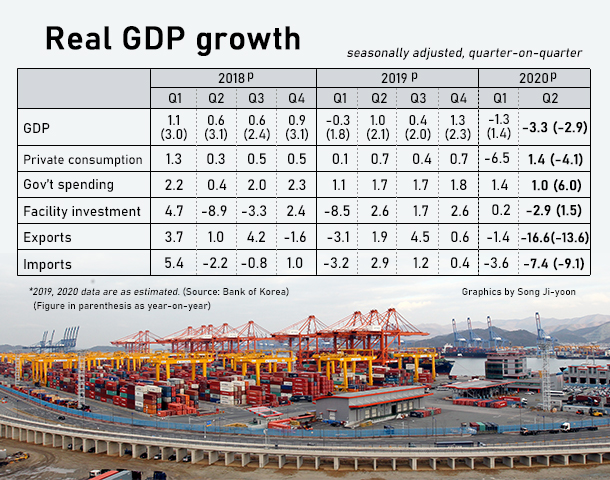![[Graphics by Song Ji-yoon]](http://static.news.zumst.com/images/18/2020/07/23/d77f0fe370fd41d3bc3a4d1e59478267.jpg) |
[Graphics by Song Ji-yoon] |
(Updated with comments, additional data)
The South Korean economy sank deeper than expected in the second quarter, declining 3.3 percent from the previous quarter and also nearly 3 percent from a year ago, as the worst pandemic in modern times took a heavy toll on global and domestic demand.
The gross domestic product (GDP) contracted 3.3 percent on quarter in April-June period on the back of 1.3 percent fall in the first three months to put Asia’s fourth largest economy in a technical recession, preliminary data from the Bank of Korea showed Thursday. Against a year ago, it was down 2.9 percent.
 |
The main Kospi fell 0.56 percent and closed Thursday at 2,216.19, while the won ended down 0.17 percent at 1,197.3 versus the U.S. dollar.
The second-quarter negative was greater than “more than 2 percent” the BOK projected a few months ago when it suggested the economy was headed for the first annual contraction since the wake of the 1997 Asian financial crisis.
“The fall in exports has been sharper than expected. The impact was bigger than the wake of the global financial crisis (of 2008-2009),” the Ministry of Finance and Economy said in a statement.
Net exports contribution to the GDP growth was negative 4.1 percentage point in the second quarter, meaning the fall in exports ate into GDP growth by more than 4 percent, compared with 3.5 percent in the second quarter of 2019.
The decline against the previous quarter and year was the worst since 6.8 percent on-quarter plunge in the first quarter of 1998 and 3.8 percent on-year fall in the fourth quarter of 1998.
Lockouts and slack economic activities across the world amidst the pandemic peak dealt heavily on demand. Exports that contribute largely to GDP plunged 16.6 percent on quarter and 13.6 percent on year. The yawning double-digit negative figure was the largest since the 24 percent plunge in the fourth quarter of 1963, BOK said.
 |
The Korean economy receded back-to-back only three times in its history – in 2003 from credit card bubble burst, 1998 when the country was international bailout, and 1970 due to global oil shock.
“The down cycle since September 2017 accelerated due to COVID-19 shock,” said Park Yang-soo, director of economic statistics bureau at BOK.
Without a growth of more than 3 percent in the second half, the economy is mostly likely to underperform BOK’s estimate of negative 0.2 percent in annual growth. The BOK will announce revised growth outlook for this year next month. At worst scenario of protracted pandemic impact, the BOK projected the economy could contract as much as 1.8 percent this year.
Government spending rose 1.0 percent on quarter and 6.0 percent on year through advanced fiscal spending plus two supplementary budgets. Private spending gained 1.4 percent on quarter thanks partly to stimuli check handouts.
But facility investment fell 2.9 percent and construction investment 1.3 percent.
Manufacturing output shrank 9.0 percent and services output receded 1.1 percent from the previous quarter.
Gross domestic income fell 2.0 percent, less severe than GDP contraction as the 7.4 percent fall in imports was slower than that of exports in the second quarter, BOK added.
[ⓒ Maeil Business Newspaper & mk.co.kr, All rights reserved]
